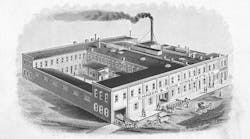Art Misiewicz never intended to become a locksmith. He was attending college with plans to become a teacher and answered a newspaper ad for a part-time job. The job was at A&A Door Check and Lock, a successful business owned by a legendary character named Joe Zastrow. Joe Zastrow wrote several articles for Locksmith Ledger during his lifetime. Joe also used a positive mental attitude with employees and customers before the phrase was ever coined.
Joe took Art Misiewicz out on service calls during his very first day on the job and the rest is history. Art describes his work days at A&A as hectic with each day finally ending after dark when the last service call was completed.
A&A was a great training ground. A&A was located in busy downtown Chicago. Art quickly learned about every part of the lock business including key cutting, door closer repair, lock installations, automotive lock work, code work and master keying. Almost everything Art Misiewicz learned at A&A would be put to good use later as an institutional locksmith.
After a stint in the Army, Art Misiewicz reconsidered his options in the locksmith field. Commercial locking systems had become his specialty. Art noted that independent locksmiths were obligated to make a profit and by necessity, they could not concentrate on servicing commercial security products exclusively. The institutional locksmith field held greater interest for him.
As opportunities arose, Art Misiewicz applied for institutional locksmith jobs. While waiting for an institutional job opening, he started his own independent locksmith business specializing as much as possible in security systems for Chicago area hospitals.
Perseverance paid off. Finally after 11 years of seeking an institutional locksmith position, Art Misiewicz landed a job as a university locksmith. He has now held that position for the past 18 years.
The former locksmith at this university left Art without an accurate key records system. Art’s first job was to decode all available keys in the existing interchangeable core lock system and re-develop the original masterkey system. Art then designed a computerized program to track keys as they are given out or received back for inventorying.
Art Misiewicz has 22 buildings and over 3500 individual door openings under his control. Several different master key systems are used. Doors requiring normal security levels are keyed into one master key system, while doors which require a higher level of security are on a different master key system. Interchangeable core locks are used throughout the university to permit immediate key changes as needed.
In addition to servicing commercial building locks across the campus, Art receives numerous weekly requests for desk keys by code.
Mechanical lock systems are currently being supplanted by electronic security which is first being employed on special-use doors such as computer rooms.
Institutional locksmiths act not only in a repair position, but also in an advisory position for management. Institutional locksmiths must keep themselves up-to-date on building codes and new security products on the market.
Art stated that he is in charge of specifying security products for both new campus construction and for building hardware upgrades. Although costs must be kept within reasonable parameters, durability is at the top of Art’s list when making hardware choices.
Art added that institutional locksmithing offers just as many challenges as there are working as an independent locksmith. At the same time, you have set work schedules so you can go home at a reasonable time each day and you don’t have to deal directly with the public. Pay is reasonable and medical insurance is usually included as part of employment. Some universities offer free college classes for workers and family members. Art Misiewicz, for one, highly recommends institutional locksmithing as a positive, satisfying occupation to consider.
Misiewicz also found time to become the president of the Greater Chicago Locksmith Association (GCLA). During Art’s tenure, the association purchased a new building in the Chicago suburbs. The building is equipped with a drive-in door for car lock demonstrations, a sound system, office area, a security resource library of books and even a pool table for leisure times. Finally, if you ever meet Art Misiewicz,, ask him about his classic Studebaker Avanti.
Sidebar
Art Misiewicz ‘s Emergency Tool box
• Tool box is plastic (won’t mar or scratch any surface)
• Universal screw driver with removable, changeable tips
• Safety glasses
• WD-40 spray can (tube shortened to fit under cover cap)
• Six-inch pieces of electrical and duct tape fastened to cover
• Small rag
• Medium-sized adjustable wrench
• Set of ball hex wrenches
• #3 Philips screw driver with square handle
• ps screw driver with extra long handle
• Needle nose pliers
• 1/8” Allen wrench with handle
• End cutters
• Medium sized square file
• Rose tightening tool for Corbin-Russwin 3600 locks
• Rose tightening tool for Schlage lever locks
• Schlage “D” wrench
• Driver tool to position lugs in IC core cylinders
• LCN door closer wrench
• Norton door closer wrench
• Probe for installing rubber door silencers
• Offset Phillips screw driver
• Mini rat tail file
• Half round file
• Small assortment of cylinder cams
• Small roll of yellow “danger do not enter” tape
• Homemade mini pin kit





